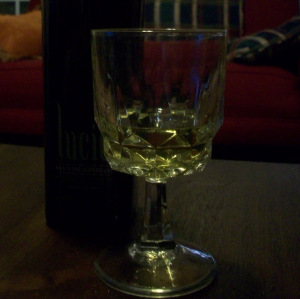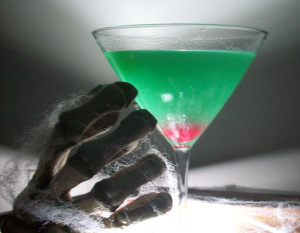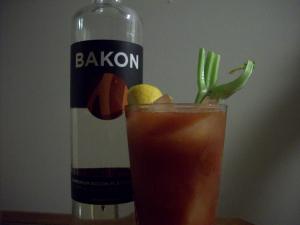Well, ladies and gentlemen, here we are. It’s been a week since the massive disappointment that was Bloody Marys, which left me gagging and barely-buzzed. I don’t think that will be a problem this week. Why? Because Skyfall comes out (in the United States) this week, and in honor of the ever-resourceful agent James Bond, we’re drinking Martinis at Six Drinks Too Many. And that means I’m getting wasted tonight.
In case you missed my rambling before Halloween, I love Martinis. It’s the king of drinks and the symbol of cocktails for a reason. There’s nothing quite like a well-made Martini, and even though it might be hard to develop a taste for such a potent and liquor-y drink, I encourage you to try one if you have not before. Maybe you’ll even find a version you like here.
But first a couple of side notes. I know I generally tell you to use good liquor, but in the case of the Martini, it is essential that you use a good gin (or other liquor depending on the Martini you’re making). You can probably find a vermouth you like for not too much money, but don’t go cheap on the gin. Personally, I prefer Plymouth gin. Find a type and/or brand that you like.
My second side note is on the eternal battle: shaken versus stirred. We all know where 007 lands in this debate, but his method actually breaks with tradition, and a lot of Martini aficionados hate James Bond — but we’ll talk about that a little bit later.
So, a Martini is traditionally stirred, and that’s because shaking a drink will affect its texture. A shaken drink will get more air in it, giving it some bubbles, and it will look cloudy. Stirring a drink will leave it crystal clear and beautiful. Shaking a drink will also melt a little bit more ice, in addition to leaving a few small slivers of ice floating on the top of your drink, diluting a little bit more than stirring it. In all honesty, this probably doesn’t make that much of a difference taste-wise, but some people will swear it does.
The advantage to shaking a drink is that it will get it cold much faster. You can get a drink equally cold by stirring, but it will take longer. Also, some people prefer the cloudy look — it makes the drink appear icy and cold. In the end, it’s a matter of preference. Try both methods, and see which you like better. Generally, recipes will tell you to stir a Martini with gin and shake a Martini with vodka, and that’s what I’ll be telling you to do in these recipes. However, I have shaken gin and I have stirred vodka, so to each their own.
Also, don’t believe people that tell you that shaking will bruise a liquor. These people have no idea what they’re talking about, but want to seem sophisticated. You can’t bruise a liquor, and the idea that you can is ridiculous. You can introduce air into it, but after a minute the bubbles will dissipate.
The last four martinis in this list are in honor of everyone’s favorite British special agent. These are special because they aren’t the traditional gin and vermouth mixes — and a lot of critics will say they’re not Martinis at all. However, they’re clearly Martini-related, and clearly variations on the old standard. So don’t be a grouch, and just enjoy a damn drink.
Now, since I talk a lot in this post, we’ll just get started.
Contents
Martini
- 2 oz Gin
- 1/2 oz Dry Vermouth
- Green Olive(s) or Lemon Twist
 This is it, in all it’s glory. The classic Martini. The 4-to-1 ratio of gin-to-vermouth is what I prefer, but you can go anywhere from the super wet Martini with a 1-to-1 ratio, or the super dry Martini with only a dash of vermouth. Of course, a lot of people like an extra dry Martini with no vermouth in it all. I don’t consider this a Martini, but if you prefer a cup of cold gin, then by all means, drink a cup of cold gin.
This is it, in all it’s glory. The classic Martini. The 4-to-1 ratio of gin-to-vermouth is what I prefer, but you can go anywhere from the super wet Martini with a 1-to-1 ratio, or the super dry Martini with only a dash of vermouth. Of course, a lot of people like an extra dry Martini with no vermouth in it all. I don’t consider this a Martini, but if you prefer a cup of cold gin, then by all means, drink a cup of cold gin.
But don’t actually drink a cup of cold gin. If you want to make a really dry Martini, there’s two good ways to do it. The first and more common way is to put a dash or two of dry vermouth in the glass before you make your drink and coat the inside of the glass with it. This will give a little bit of vermouth flavor when you strain the gin into it.
The second way is to pour some vermouth into a mixing glass with ice, stir it around for about ten seconds, and then strain it back out. This will leave the essence of the vermouth on the ice and in the glass, and when you pour the gin in, it will get a little bit of that flavor and feeling.
However, I still recommend against this, and hope you’ll prefer your Martini with at least a quarter ounce of vermouth in it. But, as with most things Martini-related, to each their own. As long as it’s gin, vermouth, and a garnish, it’s a Martini. Drop one of those ingredients, and disagreements about whether or not it’s a real Martini will follow (and certainly, any drink in a stemmed cone glass is not a Martini, no matter what modern nomenclature tells us).
Anyway, I think the 4-to-1 ratio is a good medium, and a good introduction to how Martinis taste. Its enough vermouth to smooth out the gin, but not too much to hugely affect the balance of the drink. If you haven’t tried a Martini yet, this is a good place to start.
Now let’s talk about the garnish. The olive is classic, and it’s what I prefer. Biting into an olive after drinking a Martini just feels right. However, the more understated lemon twist is also wonderful, and might be a better choice for the beginner. And besides, once you finish making your lemon twist, your hands will smell amazing, and that will help you attract a mate. I’m looking out for you.
Also, feel free to experiment some. The Martini is the perfect drink to demonstrate the importance of the garnish, as a Martini tastes wildly different depending on what garnish you use. Once you’re acquainted with the lemon twist and olive, see if you’re feeling adventurous. Try it with a sprig of basil, mint, rosemary, or some other herb to tell people that you probably shop at health food stores. Or do something wilder like an anchovy, a pepper, pomegranate seeds, or chocolate chips to tell people that you’re a weird hipster that doesn’t follow society’s rules. The Martini can be a blank canvas to accentuate the subtle notes added by any garnish, and thus display you’re unique personality, you quirky character, you.
Anyway, to make it, stir the gin and vermouth with ice and strain it into a Martini glass. You’ll want to stir until the glass or tin you’re using becomes too cold to touch — about 30 to 40 seconds. Add your garnish and enjoy.
Speaking of garnishes…
Gibson
- 2 oz Gin
- 1/2 oz Vermouth
- Pickled Pearl Onion(s)
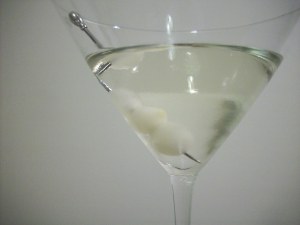 As I was just saying, garnishes are important things. A Martini with an onion instead of an olive tastes so different that it warrants a different name.
As I was just saying, garnishes are important things. A Martini with an onion instead of an olive tastes so different that it warrants a different name.
There are a few origin stories behind this cocktail, and probably none of them are true. But, they’re still a lot of fun. My favorite one is that there used to be a politician or businessman named Gibson. The story goes that good old Gibson would go on these lunches with colleagues and clients where they would drink, but he didn’t want to become inebriated and become a poor negotiator or do something embarrassing. So, our resourceful man had the waiter bring him a glass with water in it instead of a Martini. To mark his from the others, he took it with an onion instead of an olive. That’s my kind of politician.
There’s another story about how a guy named Gibson challenged a bartender to improve upon the Martini’s recipe. The bartender was a bit of a sarcastic fellow, and merely changed the garnish of the drink and offered it to his customer. I don’t like the onion better, but I hope our bartender won the bet.
Anyway, as to the taste of the drink — it’s a little bit brinier and sharper than the standard Martini. And biting into the onion(s) at the end is a VERY different experience. It’s very sharp and oddly sweet. It’s probably an acquired taste, and if my refrigerator is any indication, the Martini is superior — I’ve gone through about three bottles of cocktail olives in the time it’s taken me to use maybe ten of the onions. The Gibson isn’t bad, but it’s not as good. The olive and and the lemon have stood the test of time, and so the onion must take bronze. Awesome X-Men-esque origin stories aside, I’ll keep my glorious green friends.
Make the Gibson like you would the Martini, but garnish with the onion(s).
Let’s go super-brine now.
Dirty Martini
- 2 oz Gin
- 1/2 oz Dry Vermouth
- 1/4 oz Olive Brine
- Green Olive(s)
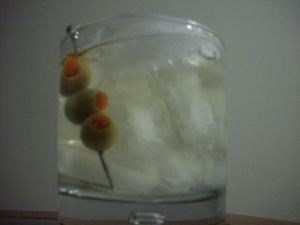 This is for Martini lovers that love the high seas and want to taste the briney deep. Arr, mateys! Avast, drink this drink with great joy, as it is quite good, and the classy lad who can drink this will have himself many wenches. It’s not for everyone, but if you can enjoy it, it is exceptional.
This is for Martini lovers that love the high seas and want to taste the briney deep. Arr, mateys! Avast, drink this drink with great joy, as it is quite good, and the classy lad who can drink this will have himself many wenches. It’s not for everyone, but if you can enjoy it, it is exceptional.
The Dirty Martini, like the Margarita, is a fantastic use of salty flavor in a cocktail. If you stop and think about it, salt isn’t a flavor you would expect yourself to want in a cocktail. However, it works very well in the right contexts, and this is one of those successes.
Also, if you looked at the picture, you’ll notice that I made this drink on the rocks instead of up. You can make a Martini either way, but on the rocks is very uncommon. It’s probably not that popular because the extra ice dilutes it more than most tastes prefer. And I agree with that — generally you should drink a Martini up. Even so, the mood may strike me to take one on the rocks, so far be it from me to keep you from enjoying the same.
I find that I like a Dirty Martini more on the rocks. Possibly because of the extra dilution, but more likely because of the extra coldness. The ice helps this drink to feel even more like the dark cold depths where an angler fish might be lurking for his cocktail, and I find that very appealing.
So, stir the liquid ingredients with ice, and strain it into an ice-filled old-fashioned glass (or into an empty cocktail glass). Add the olives (spearing them will help you out, because fishing them out of the ice can be difficult once you finish your drink), and enjoy.
Let’s move on.
Perfect Martini
- 2 oz Gin
- 1/2 oz Dry Vermouth
- 1/2 oz Sweet Vermouth
- Orange Slice
 So, in case you didn’t know, “perfect,” when it comes to cocktails, refers to a drink that has equal parts dry and sweet vermouth. It is definitely not the same kind of perfect that your grandmother says you are. Or, maybe it is the same kind of perfect, in which case I’ll drink to that.
So, in case you didn’t know, “perfect,” when it comes to cocktails, refers to a drink that has equal parts dry and sweet vermouth. It is definitely not the same kind of perfect that your grandmother says you are. Or, maybe it is the same kind of perfect, in which case I’ll drink to that.
So this amber-hued drink uses both types of vermouth. As you might have guessed, it’s sweeter than your standard Martini. However, other than that the two are similar in taste. So, if you try a Martini, and it’s just not sweet enough for you, this is a good choice. Of course, that also makes you a pussy, and I will laugh at you and point. Consider your options carefully; I have a devastating mocking laugh.
This drink is good, but I still prefer the regular Martini to it. If you want to try it, make it like any other Martini, and garnish it with the orange slice. Rim the glass with the slice so that a little bit of juice gets on the rim. Then drop the orange in. You can also perch the slice on the rim of the glass, but dropping it in will affect the taste, whereas keeping it on the side will only affect the aroma and aesthetic — a good garnish always affects the taste of the drink (with the exception of elaborate garnishes that a purely for show).
Vodka Martini
- 2 oz Vodka
- 1 oz Lillet Blanc
- Lemon Twist (or Green Olive(s) if you must)
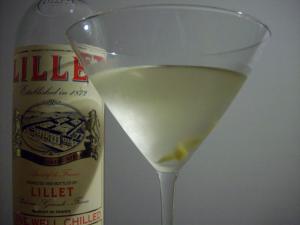 This is the drink that a lot of Martini aficionados love to hate — and it’s why they hate James Bond. You see, back in the sixties, Smirnoff had product placement rights in the James Bond films. Therefore, Jame Bond was sure to order Vodka Martinis — with Smirnoff, of course — instead drinking both Martinis with gin and Martinis with Vodka, as the agent drank in Ian Flemming’s novels.
This is the drink that a lot of Martini aficionados love to hate — and it’s why they hate James Bond. You see, back in the sixties, Smirnoff had product placement rights in the James Bond films. Therefore, Jame Bond was sure to order Vodka Martinis — with Smirnoff, of course — instead drinking both Martinis with gin and Martinis with Vodka, as the agent drank in Ian Flemming’s novels.
This helped to popularize the Vodka Martini, and vodka eventually became the most popular spirit in the United States. In fact, today the Vodka Martini is more popular than the traditional Martini with gin. This fact enrages Martini lovers everywhere. I, myself, am pretty indifferent.
You see, vodka is a neutral spirit. This means that it has little to no taste. The same things we value in other spirits is exactly what we don’t want in vodka. However, the trend with Martinis has been to make them drier and drier, meaning less and less vermouth, and in extreme cases no vermouth (this is a trend I think is dumb). Since vodka is neutral, this means that a dry Vodka Martini results in a virtually flavorless drink. Therefore, a lot of Martini lovers despise the Vodka Martini.
However, I stand by my belief that if you think vodka is flavorless, you’ve never tasted vodka. That being said, vodka is still extremely neutral, but different vodkas are still different. They have different mouth feels, different textures, and different levels of smoothness. Most importantly, though, most vodkas are not completely neutral. Many have subtle and delicate notes in their flavor, such as citrus, floral, peppery, spicy, anise, fruity, nutty, sweet, herbal, and astringent notes. The aroma also factors in when experiencing a vodka (as with any spirit), and the aroma covers an even greater ground.
If you’re interested in really tasting different vodkas and all of their subtle notes, chill a bottle of premium vodka in the freezer for a few hours, and then pour two ounces into a glass and sip it — no ice. Having it freezer-cold will bring out the right texture, and will allow you to notice the delicate flavor in the right context.
But, back to the drink at hand. Despite what its detractors will tell you, a Vodka Martini can be a very good drink. Try it, and if you like, don’t let the man tear you down. Just raise a glass in honor of 007, and tell critics to go to Hell.
You’ll want a smooth, premium vodka. Nothing too medicinal or harsh. I recommend Lillet Blanc instead of vermouth because I prefer the taste of it for a Vodka Martini, but feel free to use dry vermouth instead — it’s easier to find, in any case. Either way, though, you should make it wet. You’ll notice that I used a 2-to-1 ratio for this drink, which is pretty wet by most standards. Since vodka is neutral, using more of the balancing agent is appropriate so that you get more flavor with you drink. You’re free to try a drier version, but this is probably a more enjoyable version.
So, shake (like I said, I shake my Vodka Martinis) the liquid ingredients with ice and strain it into a cocktail glass, and garnish with the lemon twist. Use green olives for a garnish if you prefer, but with vodka, I think a lemon twist makes for a better drink.
Now let’s get a little bit more unorthodox.
Black Devil
- 2 oz Light Rum
- 1/2 oz Dry Vermouth
- Black Olive(s)
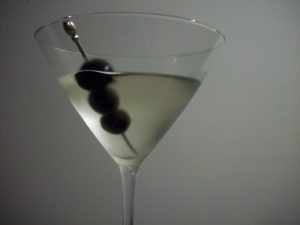 This is essentially a rum Martini. If you like rum — and I don’t mean if you like rum as an ingredient in huge mixed drinks, but really like the taste of rum — you’ll likely enjoy this. For me, rum isn’t that much of a sipping liquor. But, once again, to each their own. If you’re a rum sipper, you should definitely try this. Jack Sparrow would be proud
This is essentially a rum Martini. If you like rum — and I don’t mean if you like rum as an ingredient in huge mixed drinks, but really like the taste of rum — you’ll likely enjoy this. For me, rum isn’t that much of a sipping liquor. But, once again, to each their own. If you’re a rum sipper, you should definitely try this. Jack Sparrow would be proud
It also seems like they have Martini-garnishing down to a science. The green olive is fantastic for gin, and the black olive is fantastic for rum. In fact, the black olive is just awesome for a Martini with rum, which is interesting, considering that rum is a little bit more robust than gin, and black olives are a little bit less sharp than green olives. But, if it ain’t broke don’t fix it. The Black Devil works with the black olive (hence the name), so I suggest you try it with that.
However, making this drink with light rum still leave it a little bit insipid. Light rum is perfect for most mixed drinks — it’s lighter in flavor, and therefore it lends a little bit of rum flavor to the drink without overpowering it. However, with a Martini-style drink, the flavor of the liquor is what’s important, and it’s what’s emphasized. So, light rum doesn’t work out as well as other rums. But I’ll get to that in a second.
To make a Black Devil, stir the rum and vermouth with ice until cold, and strain it into a cocktail glass. Garnish with the black olive(s).
Now, let’s use a better rum.
Rum Martini
- 2 oz Añejo Rum
- 1/2/ oz Dry Vermouth
- Black Olive(s)
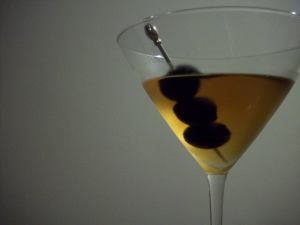 This is the same drink as above, but with a higher quality rum. For the uninitiated, añejo means aged. Aging the rum makes a more robust and flavorful rum, better for sipping than for mixing drinks. But since a Martini is a mixed drink that heavily capitalizes on the flavor of the base liquor, it’s very much appropriate to use añejo rum for this cocktail.
This is the same drink as above, but with a higher quality rum. For the uninitiated, añejo means aged. Aging the rum makes a more robust and flavorful rum, better for sipping than for mixing drinks. But since a Martini is a mixed drink that heavily capitalizes on the flavor of the base liquor, it’s very much appropriate to use añejo rum for this cocktail.
I’m still not that much of a rum connoisseur, but I know you’re all out there. If you love rum, try this drink, and you’ll have something to order at bars to make you feel classy (just be sure to explain to the bartender what you want).
In any case, I use Barcardi 8, which worked wonderfully, but use whatever añejo rum you prefer — but you could do worse.
So, stir the liquid ingredients with ice, and strain it into a cocktail glass. Garnish with the black olive(s) and enjoy it if you like rum. This is what sophisticated pirates drink, don’t you know?
On to the last drink — and quite possibly the most important drink in context of James Bond mixology.
Vesper
- 3 oz Gordon’s Gin (94 proof if you can find it)
- 1 oz Vodka (preferably 100 proof and made from grain)
- 1/2 oz Lillet Blanc
- Lemon Twist
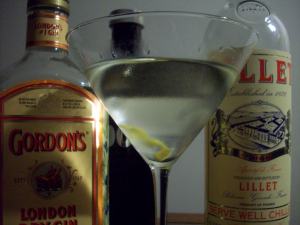 This is it. This is the ultimate James Bond cocktail. This is the drink that was introduced by James Bond in how the novel Casino Royale, and since then it’s become a drink in its own right.
This is it. This is the ultimate James Bond cocktail. This is the drink that was introduced by James Bond in how the novel Casino Royale, and since then it’s become a drink in its own right.
This is how Bond orders it in the novel which is basically how Daniel Craig orders it in the movie Casino Royale:
Three measures of Gordon’s, one of vodka, half a measure of Kina Lillet. Shake it very well until it’s ice-cold, then add a large thin slice of lemon peel. Got it?”
Bond also goes on to mention to the bartender that he ought to use a vodka made from grain instead of potatoes next time. In any case, the Vesper, named for 007’s betraying love interest, has a lot of alcohol befitting the best secret agent British intelligence has ever known.
Now is where I talk about alcohol proofs. Today, the standard for all spirits is 80 proof or 40% alcohol by volume. But, when Ian Flemming was first writing about the Vesper, gin was 94 proof and vodka was 100 proof. Therefore, if you want to be super-authentic, you aught to use appropriate liquors (these is completely optional, by the way).
Gordon’s has a 94 proof version on the American market, but the 80 proof version is much more common. You can also use a different brand, since Gordon’s is pretty low shelf, anyway, but that’s up to you. Bond orders it with Gordon’s, so I used Gordon’s. 100 proof vodka is fairly common, but 007 also prefers grain vodka over potato vodka. I used Absolut 100, but there are other brands that will meet these two criteria.
Also, Kina Lillet has been reformulated since this recipe was introduced. Your best choice now is Lillet Blanc.
Anyway, this drink is the perfect drink to make you feel good. It’s super-strong (which makes it a bad choice for my last drink of the night, but I’m a committed individual), and one will get you buzzed, or drunk depending on your tolerance (we don’t all have the iron livers of a secret agent).
Taste-wise, James Bond seems to have known what he was doing. The neutrality of the vodka helps to smooth out the roughness of the gin, and the Lillet Blanc is a delicious substitution for the vermouth. The Vesper is a fictional drink, but it’s also pretty damn good.
So, shake (we shake because 007 says to) the liquid ingredients with ice and strain it into a cocktail glass. Garnish with the lemon twist, drink it, and feel like a secret agent.
One note on the glass: Bond orders the drink in a champagne goblet, as at the time cocktail glasses were much smaller, and couldn’t have held his gigantic drink. However, cocktail glasses have gotten progressively bigger over time, and as such champagne goblets (which are infinitely inferior to to champagne flutes), fell out of favor. Use whichever you have access to.
Denouement
I’m drunk. James Bond is a pretty rad dude. Martinis are awesome drinks. I’m not writing anymore.
Have a good time at the movies. Stay classy, Internet.


